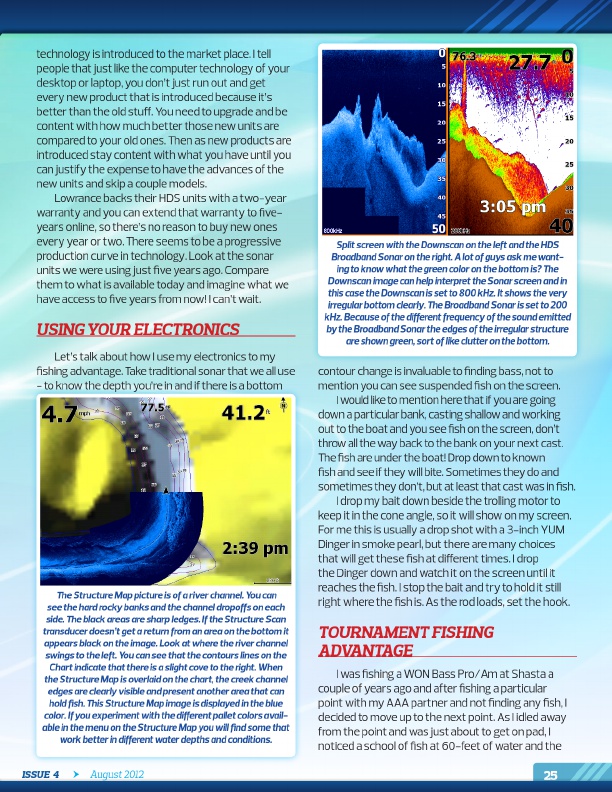
technology is introduced to the market place. i tell people that just like the computer technology of your desktop or laptop, you don’t just run out and get every new product that is introduced because it’s better than the old stuff. You need to upgrade and be content with how much better those new units are compared to your old ones. Then as new products are introduced stay content with what you have until you can justify the expense to have the advances of the new units and skip a couple models. lowrance backs their HdS units with a two-year warranty and you can extend that warranty to five- years online, so there’s no reason to buy new ones every year or two. There seems to be a progressive production curve in technology. look at the sonar units we were using just five years ago. Compare them to what is available today and imagine what we have access to five years from now! i can’t wait.
USING YOUR ELECTRONICS
let’s talk about how i use my electronics to my fishing advantage. take traditional sonar that we all use - to know the depth you’re in and if there is a bottom
Split screen with the Downscan on the left and the hDS Broadband Sonar on the right. A lot of guys ask me want- ing to know what the green color on the bottom is? The Downscan image can help interpret the Sonar screen and in this case the Downscan is set to 800 khz. It shows the very irregular bottom clearly. The Broadband Sonar is set to 200 khz. Because of the different frequency of the sound emitted by the Broadband Sonar the edges of the irregular structure are shown green, sort of like clutter on the bottom.
The Structure Map picture is of a river channel. You can see the hard rocky banks and the channel dropoffs on each side. The black areas are sharp ledges. If the Structure Scan transducer doesn’t get a return from an area on the bottom it appears black on the image. Look at where the river channel swings to the left. You can see that the contours lines on the Chart indicate that there is a slight cove to the right. When the Structure Map is overlaid on the chart, the creek channel edges are clearly visible and present another area that can hold fish. This Structure Map image is displayed in the blue color. If you experiment with the different pallet colors avail- able in the menu on the Structure Map you will find some that work better in different water depths and conditions.
Issue 4
August 2012
contour change is invaluable to finding bass, not to mention you can see suspended fish on the screen. i would like to mention here that if you are going down a particular bank, casting shallow and working out to the boat and you see fish on the screen, don’t throw all the way back to the bank on your next cast. The fish are under the boat! drop down to known fish and see if they will bite. Sometimes they do and sometimes they don’t, but at least that cast was in fish. i drop my bait down beside the trolling motor to keep it in the cone angle, so it will show on my screen. For me this is usually a drop shot with a 3-inch YUM dinger in smoke pearl, but there are many choices that will get these fish at different times. i drop the dinger down and watch it on the screen until it reaches the fish. i stop the bait and try to hold it still right where the fish is. as the rod loads, set the hook.
TOURNAMENT FISHING ADVANTAGE
i was fishing a Won Bass Pro/am at Shasta a couple of years ago and after fishing a particular point with my aaa partner and not finding any fish, i decided to move up to the next point. as i idled away from the point and was just about to get on pad, i noticed a school of fish at 60-feet of water and the
25